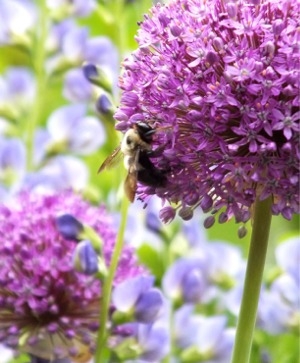
Latin for garlic, Allium, the Flowering Onions, are available in diverse heights and sizes, are rabbit-, rodent- and deer-resistant, and are seldom affected by disease. Adored by bees, butterflies and pollinators, Allium extend the spring flowering season with bold, dramatic color and center-stage, statuesque garden architecture, or lush, delicate clusters of florets that gracefully adorn garden borders. Gleeful bees happily bumble from Allium floret to floret in grateful awe of their floral largesse. Allium are also valuable as cut and dried flowers.
Most varieties of the globe-shaped Allium have an incredibly long garden presence. The stalks emerge from strappy, low-growing foliage, the thick cigar-like buds form and a spidery outline of the globe develops as up to hundreds of star-shaped florets burst into bloom with delicate filament-like stamens. As the flowers die back after weeks of powerful presence, the dried seed pod form of the globe remains, like a hauntingly beautiful garden sentry.
There is nothing better after the brilliant opening act of Narcissi and Tulips than to anticipate the stunning second act of Allium, Brodiaea, Camassia, Eremurus, Dutch Iris and soon thereafter, Herbaceous Peonies. (You may also want to experiment with Gladiolus communis ssp. byzantinus, Ixiolirion tataricum ssp. pallasii, Ornithogalum ponticum Sochii and Oxalis adenophylla.) Soon thereafter, one can look forward to the opulent finishing act of Lilies.
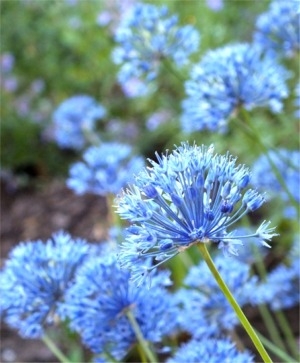 Heirloom Allium
Heirloom Allium
If you are looking for heirloom flower bulbs, you’ve hit the jackpot with Allium. There are few flower bulbs native to the U.S., but A. amplectens Graceful Beauty is one of them.
1857 A. amplectens Graceful Beauty (American)
1800 A. atropurpureum
1830 A. azureum
1800 A. caesium
1884 A. christophii
1823 A. cowanii
1876 A. karataviense
1823 A. neapolitanum
1762 A. nigrum
1896 A. schubertii
1873 A. siculum bulgaricum
1594 A. sphaerocephalon
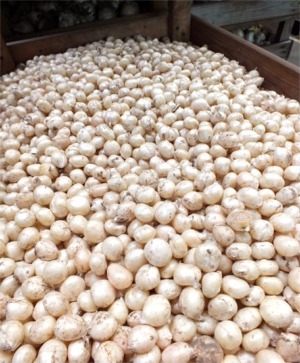 Horticultural Zone Hardiness
Horticultural Zone Hardiness
Each variety of Allium has its own hardiness zone requirements that should be considered when selecting varieties for your garden. If your garden is in a horticultural zone that is either too cold or only marginally appropriate, you may want to apply no more than a 2" layer of mulch after the ground surface freezes in the fall. The mulch should trap the cool temperatures into the soil, not warmth. Mulch helps to protect the bulbs from arctic temperature spikes. Good mulching mediums include straw, salt marsh hay or oak leaves. In the spring, you can loosen the mulch in the area in which the Allium will be sprouting.
Bulb Inspection
Check your shipment against the packing slip and make sure that everything is as it should be. Occasionally, bags of smaller bulbs may be placed in the inner boxes of other bulbs to reduce jostling during shipment. If you can’t find something, open all of the inner boxes. If there is a discrepancy, please call us immediately so that we may resolve it with you. Since every bag or box of bulbs in your order has been scanned using its UPC barcode, we can usually tell you in which box each variety is located.
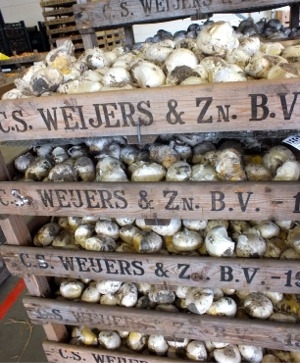 Inspect your bulbs carefully. We make every effort to ship you only healthy, firm, top quality bulbs.
Inspect your bulbs carefully. We make every effort to ship you only healthy, firm, top quality bulbs.
Allium bulbs look different from other types of flower bulbs like Tulips or Narcissi. It is natural for some types of bulbs to develop a transportation mold when they are exposed to oxygen. It is a natural gray-blue-green mold that occurs when they are exposed to air, and that disappears as soon as the bulbs are planted. The soil naturally wicks it away. If you prefer, you may spread the bulbs out in the sun, or brush it off with a paper towel although it is not necessary.
Little cuts, scars, discolored exteriors and dimples are normal marks from the flower bulb harvesting, cleaning and sizing processes in the Netherlands. Some bulbs may have a fully intact, papery skin while others have partial skins, and others may be skinless. The existence or condition of the skin has nothing to do with the performance of the bulb. The most important factor is the way that the bulb feels. As long as the bulb is firm, it is a good and viable bulb. Some bulbs may already have tiny baby bulbs developing on the basal plate (root base) of the bulb while others may even have a little top shoot. Some bulbs are prettier than others, but you can rest assured that all of the flowers will be gorgeous!
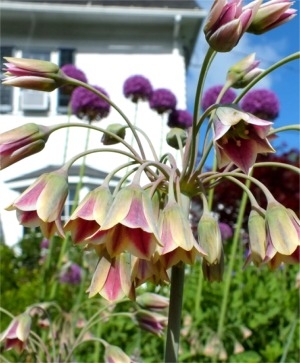 Sometimes, you might find a large Allium bulb that appears flat on one side....like a big tear drop with a flat side. It appears like this because the strong woody stem of the Allium came out after dying back in the spring, and the bulb was so huge that it split apart as it continued to grow. Rest assured that this split-apart is a perfectly wonderful bulb, it just looks different from other bulbs. Other times, you might find a beautiful bulb with a hole in the top. Again, this is where the woody stem of the Allium split apart from the bulb after it bloomed and died back in the spring. It’s all good, all natural. Some people plant the bulbs with a hole in the top at an angle to prevent water collection. We don’t know if that really makes any difference since water flows in all directions underground.
Sometimes, you might find a large Allium bulb that appears flat on one side....like a big tear drop with a flat side. It appears like this because the strong woody stem of the Allium came out after dying back in the spring, and the bulb was so huge that it split apart as it continued to grow. Rest assured that this split-apart is a perfectly wonderful bulb, it just looks different from other bulbs. Other times, you might find a beautiful bulb with a hole in the top. Again, this is where the woody stem of the Allium split apart from the bulb after it bloomed and died back in the spring. It’s all good, all natural. Some people plant the bulbs with a hole in the top at an angle to prevent water collection. We don’t know if that really makes any difference since water flows in all directions underground.
However, if you find an Allium bulb with a discolored spot that is soft and you can push your finger into it, please call us. This rarely happens, but if it does, let us know and we will take care of it. That is not a good thing.
Bulb Size
Each Allium variety makes its own special top size bulb. Some are as small as 4 centimeters, while others are 20 centimeters/up!
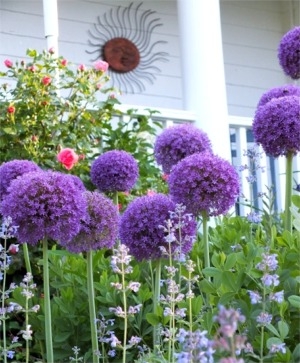 If you find that one bag of Allium bulbs contains larger and smaller bulbs, it is a glass half full or half empty issue. Each of the bulbs is, at a minimum, the top size specified for that variety. They are sized on conveyor belts in the Netherlands that have holes the centimeter size just below the top size measurement. Smaller bulbs fall through these holes and are not included in our stock. All of the larger bulbs are included in our stock, and, as a result, there can be size variation. But it is definitely a glass half full! (If any variety in any season produces a smaller top size bulb than expected, we note it on our website. If a price change occurs as a result, we post the new price and make an adjustment on every order.)
If you find that one bag of Allium bulbs contains larger and smaller bulbs, it is a glass half full or half empty issue. Each of the bulbs is, at a minimum, the top size specified for that variety. They are sized on conveyor belts in the Netherlands that have holes the centimeter size just below the top size measurement. Smaller bulbs fall through these holes and are not included in our stock. All of the larger bulbs are included in our stock, and, as a result, there can be size variation. But it is definitely a glass half full! (If any variety in any season produces a smaller top size bulb than expected, we note it on our website. If a price change occurs as a result, we post the new price and make an adjustment on every order.)
Bulb Storage Before Planting
After you’ve received your order and inspected it, keep the exterior carton and the inner boxes open to give the bulbs some air. All bulbs love good air circulation. Store them in a cool, dry place with low humidity, away from heat, frost and strong sunlight at about 50°F to 70°F. Never put flower bulbs in the freezer! Poor storage conditions could cause bulbs to dry out, or to become moldy.
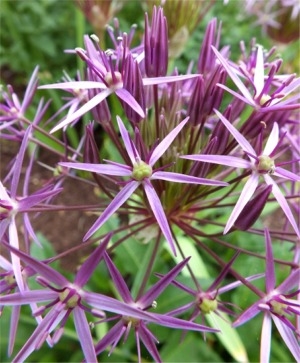 Select and Prepare the Planting Site
Select and Prepare the Planting Site
All Allium require rich, well-draining and neutral pH soil. The best soil is a sandy loam. For clay soil, break up the clay about a foot deeper than the planting depth of your bulbs and amend the bed with sand, peat moss and/or well-aged, neutral pH compost. For excessively sandy soil, amend the bed with peat moss, aged leaf compost and/or well-aged, neutral pH compost.
Please do not ever add horse manure, chicken droppings, mushroom compost, other hot manure or immature compost to your flower bulb beds. If you would like to add compost you’ve made yourself, please make sure that it is completely decomposed, healthy and neutral pH. Partially decomposed compost can spread fungal disease, such as botrytis blight, and nasty pests. What is good for vegetables is not necessarily good for flower bulbs.
Allium require full sunlight (a minimum of six hours per day) although there are several varieties that can also thrive in partial or filtered sunlight, like A. cowanii and siculum bulgaricum.
Most Allium can handle, and even benefit from, a summer dry period.
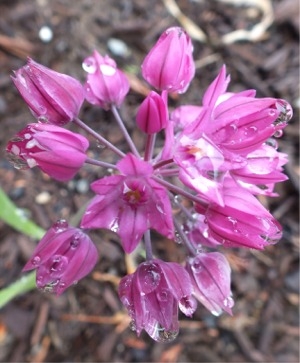 Easy to Plant
Easy to Plant
Allium bulbs are so easy to plant and are really low maintenance. We'll ship you the bulbs in time for planting in your garden in the fall, once the ground has chilled down to about 55°F, after about two weeks of sweater weather when night time temperatures have hovered in the 40s. This is the best time to plant Allium bulbs. Flower bulbs do everything in response to temperature and sunlight. If bulbs are planted too early, before the ground has chilled down to around 55°F, they may grow unnecessary top growth, which could diminish their vitality in spring. If they are planted too late, all-important root system growth could be hampered. Immature, underdeveloped root systems could result in more foliage than flowers. Not good.
Plant the big bulbs 6" to 8" deep and 8" to 10" apart and plant the smaller bulbs 4" deep and 3" to 4" apart. Please do not put anything in the bottom of hole that you’ve dug for the bulbs. Even if you think it is good for the bulb, it could cause root burn. Nestle the bulb into its hole, fill in the hole with soil to the level of the bed, and tamp down the soil lightly, making sure that individual holes are no longer apparent and that the garden bed surface is level. This will help to prevent water from filling up any of the individual planting holes. All flower bulbs hate to get wet feet.
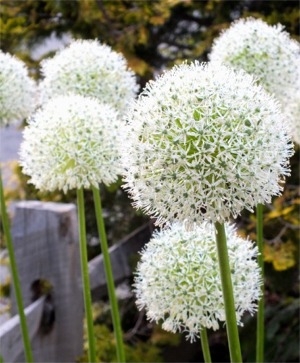 Fertilizing
Fertilizing
Never put anything, including fertilizer, in the bottom of each bulb planting hole. To do so is to run the risk of root burn. Plant the bulbs to the proper depth and spacing, tamp down the soil and broadcast a 5-10-5 or 4-10-6 granular organic fertilizer over the surface of the bed as if you were feeding the birds.
While all flower bulbs are nature’s perfect little packages and will bloom beautifully the first year, we recommend broadcasting fertilizer three times a year for all perennial and naturalizing flower bulbs. First at the time of fall planting to help grow the roots, second when the sprouts emerge in the spring to help nourish the foliage and flower, and finally, when the flowers start to die back to help feed the bulb itself. Bone meal is incomplete nutritionally and can attract animals to some varieties of bulbs (like Crocus or Tulips).
Do Not Plant Allium in Exterior Containers /Raised Beds
Flower bulbs should never be planted in outdoor containers, window boxes or raised beds where bulbs experience temperature spiking and repeated cycles of freezing and thawing. This results in root growth failure, root system destruction, frozen bulbs and/or bulb rot from poor water drainage. Flower bulbs must have a consistent cold winter temperature with good water drainage in order to produce a mature root system that will permit foliage growth and flower production in the spring.
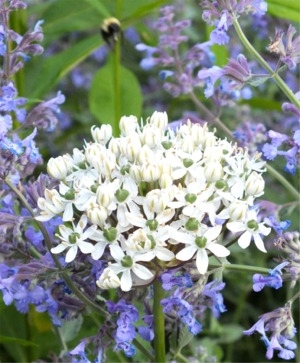 Bloom Times, Size and Color
Bloom Times, Size and Color
The bloom time listed for each variety is for horticultural zone 5 in normal spring conditions. The warmer the horticultural zone, the earlier flower bulbs will bloom. The colder the horticultural zone, the later flower bulbs will bloom in the spring.
Flower bulbs do everything in response to temperature, sunlight and site conditions. Bloom times, heights and colors are approximations affected by temperature and site conditions regardless of the calendar date. If it is a warm spring, bulbs will bloom earlier. If it is a cold spring, bulbs will bloom later. If it is a long cool spring, followed by rapid warming, you may find odd bedfellows: earlier blooming Galanthus flowering right along side later blooming Crocus, Species Tulips and Narcissi. Each spring can offer a different sort of garden surprise party.
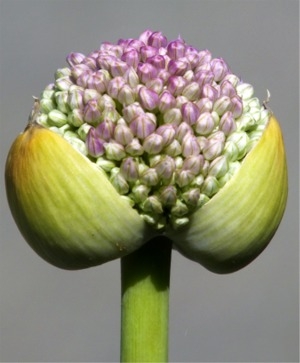 In the event of a mild winter or a warmer-than-usual spring, flower bulbs that have emergent stalks with set buds may bloom early, small and short, although they will likely grow taller and larger as temperatures moderate. Temperature spikes can also affect mature root development, the actual form of the flower or the process of flower color maturation.
In the event of a mild winter or a warmer-than-usual spring, flower bulbs that have emergent stalks with set buds may bloom early, small and short, although they will likely grow taller and larger as temperatures moderate. Temperature spikes can also affect mature root development, the actual form of the flower or the process of flower color maturation.
Spring Care
Allium have all different sorts of stems and stalks, buds and flowers. Allium schubertii initiates spring growth with a low rosette of foliage from which a stout stem emerges sporting a thick paint brush of a bold bud. Allium sphaerocephalon emerges with thin wiry stems that could be mistaken for weeds. Allium Forelock develops thin stems sparsely covered with leaf-like foliage: the sheath-covered buds point in all directions atop the wiry stems that dance among themselves in wild curly-cues. Allium Ambassador, Gladiator, Globemaster and Pinball Wizard have thick stalks that boldly come forth with incredibly buxom buds whose sheaths finally burst open to reveal tightly compacted florets waiting to explode. Allium siculum bulgaricum stealthily enters the garden with slender green stalks from which paper-sheathed hot Chile pepper look-alikes, kind of like vegetative spears, appear.
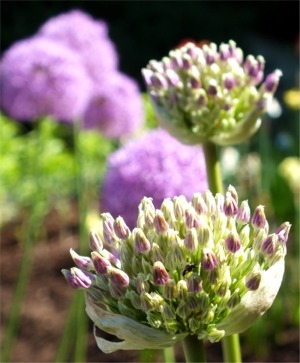 Although it is not pretty, it’s completely natural that the low-growing foliage of some Allium, particularly the large globe-shaped varieties, starts to yellow and brown out before and/or during the bloom period. We’ve known some fastidious gardeners who have trimmed off the dead Allium foliage tips prior to Garden Conservancy Open Days, but we recommend letting it do its thing. Just don’t focus on it. It’s a small price to pay for such magnificence.
Although it is not pretty, it’s completely natural that the low-growing foliage of some Allium, particularly the large globe-shaped varieties, starts to yellow and brown out before and/or during the bloom period. We’ve known some fastidious gardeners who have trimmed off the dead Allium foliage tips prior to Garden Conservancy Open Days, but we recommend letting it do its thing. Just don’t focus on it. It’s a small price to pay for such magnificence.
Once Allium bloom and start to die back, make sure to keep the foliage going until it dies back naturally. A maximum period of photosynthesis allows the bulbs to regenerate for the future. Once the foliage is completely yellowed or browned out, remove it from the garden.
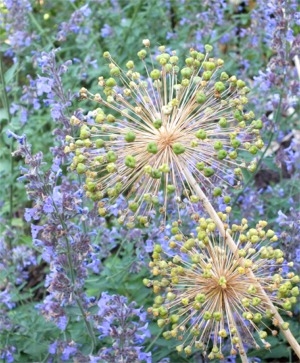 Don’t forget that Allium are amazingly wonderful cut flowers! One year, Mother Nature condensed our spring bloom period and the big globe-shaped Allium were blooming at the same time as the Peonies. Allium Globemaster and Peony Eden’s Perfume were stunning in a tall vase for Father’s Day.
Don’t forget that Allium are amazingly wonderful cut flowers! One year, Mother Nature condensed our spring bloom period and the big globe-shaped Allium were blooming at the same time as the Peonies. Allium Globemaster and Peony Eden’s Perfume were stunning in a tall vase for Father’s Day.
The larger globe-shaped Allium are also terrific dried flowers. It’s fun to experiment with them: one year, my sister spray painted dried Allium Globemaster orbs gold. Fun.
Forcing
While most Allium are not recommended for forcing over the winter, there are several varieties that are known to be good forcers, like A. cowanii and karataviense.
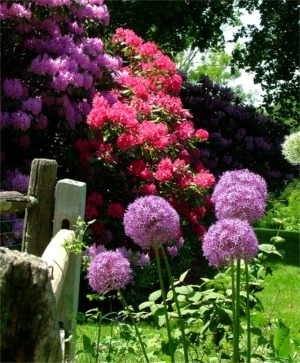 In general, to force any of these select varieties of Allium, one would pot the bulbs in mid-October and prechill them at a consistent, dark 38°F to 45°F with moderate watering for eight to ten weeks. At the end of the precooling period, bring the pots out of refrigeration into progressively stronger sunlight with moderate watering. They usually bloom around four weeks later. Once Allium bulbs are forced, their vitality is spent and the bulbs may be discarded.
In general, to force any of these select varieties of Allium, one would pot the bulbs in mid-October and prechill them at a consistent, dark 38°F to 45°F with moderate watering for eight to ten weeks. At the end of the precooling period, bring the pots out of refrigeration into progressively stronger sunlight with moderate watering. They usually bloom around four weeks later. Once Allium bulbs are forced, their vitality is spent and the bulbs may be discarded.
Trouble Shooting
If Allium are yielding more foliage than flowers, it normally indicates a root system issue. A mature planting may need to be dug up in the fall, and transplanted to the original depth and spacing after carefully separating the bulbs that may have been strangling themselves. Sometimes, the larger Allium bulbs grow to the point that they split apart at the area where the woody stem has separated itself from the bulb. It can take years for each split-apart bulb to grow to the size whereby it would fully flower again. Please do keep the foliage growing and dying back naturally during this time.
It may not happen often, but we’ve found that on occasion, Allium aflatunense Purple Sensation has reseeded itself and popped up happily in other parts of the garden.
Horticultural Restrictions
We are very sorry, but due to state agricultural restrictions, we are not permitted to ship Allium bulbs to Idaho, or to the following five counties in the State of Washington: Adams, Benton, Franklin, Grant and Klickitat.




